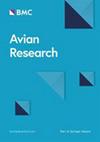视觉线索调节日本山雀的巢防御行为:从蛇假人的外观,姿势和大小的见解
IF 1.7
2区 生物学
Q1 ORNITHOLOGY
引用次数: 0
摘要
捕食者假人通常用于探索捕食者特征对鸟类反捕食者行为的影响。先前的研究表明,空中捕食者的形态和行为可以表明对鸟类的不同威胁程度。然而,地面捕食者假体的细微变化是否会导致亲本鸟类的巢保护行为发生变化尚不清楚。在这项研究中,我们旨在调查日本山雀(Parus minor)是否表现出不同的巢穴防御行为,以响应实验操纵的虚拟蛇代理(常见的巢穴捕食者)的外观、姿势和大小的变化。在孵育期间,我们观察了亲本山雀对不同特征西伯利亚鼠蛇标本和橡胶模型蛇的护巢行为。山雀对大型蛇(体长约120 cm)标本的反应比对大型蛇模型的反应更强烈。它们对小的(体长约20厘米)卷状鼠蛇的反应弱于对小的蛇形鼠蛇的反应。此外,它们对大盘曲鼠蛇标本的反应比对小盘曲鼠蛇标本的反应更强烈,对小盘曲鼠蛇标本的反应比对大模型蛇标本的反应更强烈。然而,山雀对小正弦鼠蛇标本和大螺旋鼠蛇标本的反应没有差异,对小螺旋鼠蛇标本和模型蛇标本的反应也没有差异。因此,鳞片、正弦波姿势和体型较大的假蛇可以引起日本山雀更强烈的行为反应。我们认为,日本山雀可以区分地面捕食者假人的细微差异,并表现出不同的巢防御行为。本文章由计算机程序翻译,如有差异,请以英文原文为准。
Visual cues modulate nest defense behavior in Japanese Tits: Insights from the appearance, posture and size of snake dummies
Predator dummies are usually used to explore the impact of predator features on the anti-predator behavior of birds. Previous studies have shown that the morphology and behavior of aerial predators can signal different threat levels to birds. However, whether subtle changes in ground predator dummies cause changes in the nest defense behavior of parent birds is unclear. In this study, we aimed to investigate whether Japanese Tits (Parus minor) exhibit different nest defense behaviors in response to experimentally manipulated variations in the appearance, posture, and size of virtual snake proxies (common nest predators). During the incubation period, we observed the nest defense behaviors of the parent tits against taxidermized Siberian Ratsnakes (Elaphe schrenckii) with varied characteristics and rubber-made model snakes. The tits exhibited more intense responses to taxidermized large (body length about 120 cm) coiled ratsnakes than to large coiled model snakes. They exhibited weaker responses to taxidermized small (body length about 20 cm) coiled ratsnakes than to taxidermized small sinusoidal ratsnakes. In addition, they exhibited more intense responses to taxidermized large coiled ratsnakes than to taxidermized small coiled ratsnakes, and more intense responses to taxidermized small sinusoidal ratsnakes than to large model snakes. However, there was no difference in the response of tits to taxidermized small sinusoidal ratsnakes and taxidermized large coiled ratsnakes, or to taxidermized small coiled ratsnakes and model snakes. Thus, the presence of scales, a sinusoidal posture, and a large body size of snake dummies can induce more intense behavioral responses in Japanese Tits. We suggested that Japanese Tits can discriminate subtle differences in ground predator dummies of nests and exhibit different nest defense behaviors.
求助全文
通过发布文献求助,成功后即可免费获取论文全文。
去求助
来源期刊

Avian Research
ORNITHOLOGY-
CiteScore
2.90
自引率
16.70%
发文量
456
审稿时长
46 days
期刊介绍:
Avian Research is an open access, peer-reviewed journal publishing high quality research and review articles on all aspects of ornithology from all over the world. It aims to report the latest and most significant progress in ornithology and to encourage exchange of ideas among international ornithologists. As an open access journal, Avian Research provides a unique opportunity to publish high quality contents that will be internationally accessible to any reader at no cost.
 求助内容:
求助内容: 应助结果提醒方式:
应助结果提醒方式:


